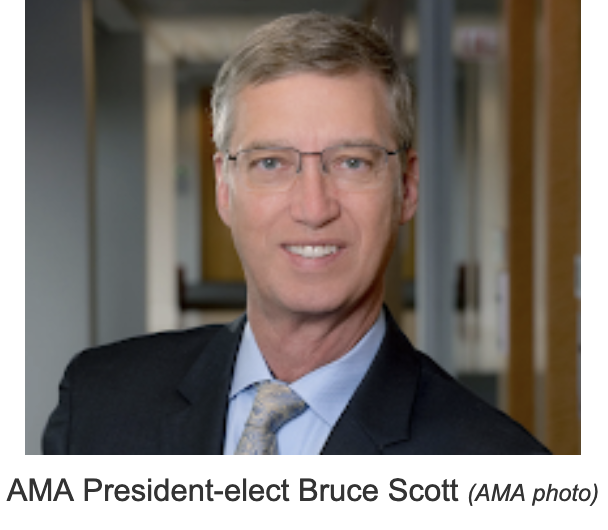AMA president-elect, from Louisville, lays out his ideas for getting more physicians in rural areas, reforming prior authorization

With about 46 million people in the U.S. living in rural areas and new research showing they are more likely to die early from the five leading causes of death than their urban counterparts, the American Medical Association is sounding the alarm.
“Rural health is America’s health,” Dr. Bruce Scott of Louisville, AMA president-elect, told reporters in a May 9 press conference in conjunction with the National Rural Health Association annual conference in New Orleans. “We need policymakers to understand that the American Medical Association is deeply concerned about the ever-widening health disparities between urban and rural communities. disparities that are at the root of why rural Americans suffered disproportionately high rates of heart disease, cancer, stroke, respiratory illness, diabetes, and unintentional injuries.”
Scott, who is board-certified in both otolaryngology and facial plastic surgery, served as the Kentucky Medical Association‘s president in 2018-19. He will become AMA president in June.
Scott pointed to several environmental, economic and social factors factors that put people who live in rural communities at a higher risk of death from these often preventable conditions. But the AMA’s focus, he said, is on the health-care worker and the physician shortage and how this affects rural people’s health.
He added that these shortages are hitting rural areas the largest and are “creating health-care trends that are simply unacceptable. We need to reverse these trends for all individuals to live a long, healthy and active life.”
Scott said rural areas have about 30 physician specialists for every 100,000 residents, compared to 236 per 100,000 in urban communities, and he noted that more than 130 rural hospitals closed from 2010 to 2021, with many more on the verge of closing today.
Also, he said that in 2023, 65% of rural communities had insufficient access to primary-care physicians, including pediatricians. And, he said there are not enough residency spots to train doctors in rural areas.
“History has shown us that residents, 80% of the time, tend to wind up practicing within 80 miles of where they’ve done the residency,” Scott said. “So residency location becomes very important. In addition, medical schools are receiving fewer and fewer applicants from individuals from rural areas.”
Call for Medicare reform
Scott said the AMA is working to build a stronger physician workforce, which he said starts with supporting physicians who are already in practice, to keep them practicing.
“AMA is focused on fixing the systemic issues of our health-care system that are known to be driving physician burnout, and contributing to early retirement and physicians leaving practice altogether,” he said. “Highest among these problems are the broken Medicare physician payment system and the administrative burdens.”
The problem, said Scott, is that Medicare payments to doctors are not keeping up with inflation. He said that when adjusted for inflation, the payment rate to physicians has dropped 29% since 2001, and private payers and other insurers have linked their payments to the Medicare structure.
“We need a system that is sustainable, predictable, and provides at least an annual inflation update that encourages patients choice rather than consolidation,” he said. “We need Congress to act.”
Administrative burdens
Scott said physicians spend two hours on administrative work for every one hour with patients, contributing to burnout and hindering patient care.
A key contributor to this is “prior authorization,” which requires a physician to get approval from a third-party payer for care that the physician and patient have agreed on before it can be implemented.
“On average, physicians complete 45 prior authorizations per week and it’s even worse in primary care,” Scott said. “The prior authorization process is overused, overly burdensome and wastes physicians’ time. But I’m even more concerned about the fact that prior authorization hurts patients.”
He added, “We need Congress and payers and the administration to respond, because the result is that physicians are getting burned out and they’re leaving practice, not because they don’t want to practice medical care anymore, but because the system is making it more and more difficult for them to care for their patients.”
During the 2024 legislative session, Rep. Kim Moser, R-Taylor Mill, again filed a bill to address the prior authorization issue in Kentucky, but health insurers blocked it. It would have exempted from the process health-care providers who have had 90% or more of their claims approved.
Scott said the AMA is “fighting for legislation fixes” to increase incentives for physicians to work in rural areas, to expand the number of residency spots, particularly in primary care and in rural areas, to make the pandemic’s telehealth flexibilities permanent, and to allow qualified international medical graduates to keep practicing in America.
Asked about the role of advanced-practice registered nurses and physician assistants to help increase access to care in rural areas, Scott said that “there is absolutely” a role for these “physician extenders” in a physician-led team model.
“The AMA believes strongly in the concept of a physician-led medical team, where every component of the team is working to the highest level of their knowledge base and their experience,” he said. “Now, we’re not in favor of independent practice for nurse practitioners or PAs. We think that patients, no matter what ZIP code they happen to live in, deserve care by a physician.”